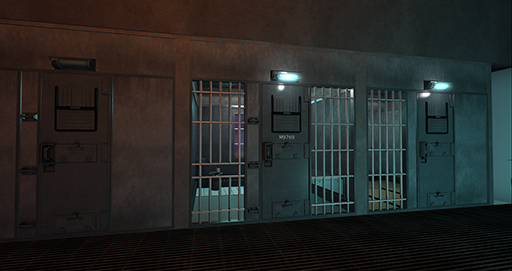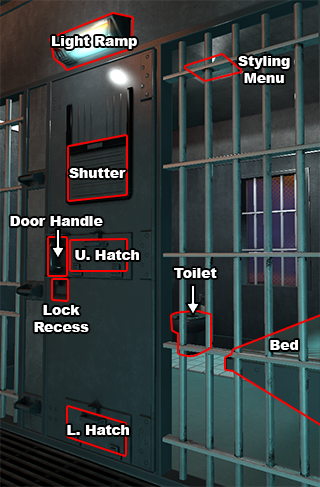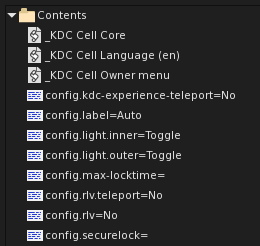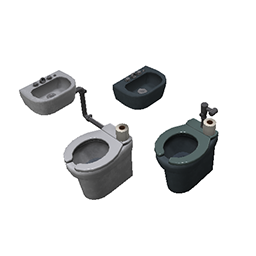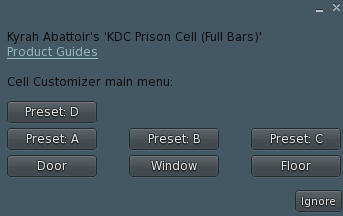Table of Contents
Documentation for the KDC Prison Cell & KDC Narrow Cell
The expansion of the KDC facilities led to the acquisition of the remains of a federal correctional facility that had ended up decommissioned before it had a chance to pay itself back. One of our interns suggested that we could probably refurbish the brand new containment units as “private prison cells you can install at home”.
Supported TouchBound functions
Sensing zones
The KDC prison cell is set up to hide the “click/touch” cursor when on an area that cannot be interacted with. The following zones can be interacted with:
- Ceiling light/root - (owner only) Click here to open the aspect menu.
- Door handle - Click here to open/close the door.
- Upper hatch
- Lower hatch (not available on the padded variant)
- Window shutter
- Light ramp - Turns the light on & off.
- Lock recess - Where TouchBound padlocks are installed to lock the door, double click to open the TouchBound Info Box.
- Bed & Toilet - Click to sit on them.
Supported locks
- Accessories.
Touch restrictions
For increased realism, the KDC Prison cell script performs advanced checks to decide whether you can interact with it at any given time. Most of the touch restrictions begin effect once the cell door is closed.
- All actions in the cell are restricted to a 2-meter range from the exact point you are trying to click.
- Avatar inside the cell cannot operate the hatches or the shutter if the door is closed.
- They can pull the handle or manipulate the lock/recess, but only if the upper hatch is open. (Otherwise they can't reach out obviously :) )
- The built-un Lightbar can only be used by avatars directly facing it.
RLV & Experience
By default, the KDC Prison cell will attempt to apply RLV restrictions to all the cell occupants with an RLV Relay, as soon as the door is closed.
- Touch distance to 1.5m maximum.
- Cannot use landmarks to teleport.
- Cannot be teleported by others.
- Cannot teleport home.
- Cannot edit the KDC Prison Cell itself.
If The KDC Experiment Second Life experience is enabled on the current parcel, it will also use this feature to recapture avatars that manage to get out of the cell. NOTE: If RLV-Relay teleport is enabled, the cell will only attempt to use RLV teleport if it cannot use experience teleport.
Configuring the cell
The KDC Prison Cell has a number of configuration flags built-in, they use the typical way of renaming notecards to enable/disable a given feature.
If you aren't sure of the syntax for a given flag, a brief explanation can be read within the notecard itself.
config.rlv.teleport
Rename this notecard to enable/disable the RLV-based prisoner escape prevention.
IMPORTANT! Do not enable this feature unless parcel teleport routing is set to “Anywhere”! (About Land > Options > Teleport Routing)
If enabled, the cell will periodically check for escapees (within the same region) and teleport them back into the cell if they have an RLV Relay.
- config.rlv.teleport=Yes
- config.rlv.teleport=No
NOTE: If Experience & RLV-Relay teleport are both enabled, the cell will only attempt to use RLV teleport if it cannot use experience teleport.
config.rlv.camera
Controls the RLV-relay camera restrictions.
- config.rlv.camera=No: No camera restrictions will be applied.
- config.rlv.camera=Yes: Prisoners with an RLV relay will have their camera restricted to a short range.
- config.rlv.camera=Mouse: Prisoners with an RLV relay will be forced to use Mouselook (RLV) or an extremely tight camera range (RLVa).
RLV Build/Edit prevention
Note: While this function is available for the 3 cell models, due to a packaging error on the current version, the configuration card is NOT present and has to be manually added if you want to turn the function on.
config.rlv.nobuild=Yes : Cell occupants with a relay won't be able to build or edit objects. config.rlv.nobuild=No : Default.
Regardless of this function's state, the cell will still attempt to set itself to no-edit for all occupants, which can prevent opening the build menu through the right click/edit dialog. Of the function is disabled, You can still open the build menu by right-clicking an attachment/other object or CTRL+B.
config.label
The KDC Prison Cell door has a built-in, configurable 5 character label.
In “Auto” mode, when the door is closed, the cell will generate a permanent prisoner ID according to the first avatar found inside the cell.
- For legacy accounts with a last name: A0000 to Z9999.
- For regular accounts: 00000 to 99999.
If you'd prefer to use your own label or to make it static, you can use up to 5 characters (or turn the feature off by leaving the option blank). Supported characters: A-Z a-z 0-9 dashes (-) and dots (.)
- config.label=Auto: The door label will be auto-generated.
- config.label=<Text>: The door label will be <Text> (5 characters max).
- config.label=: The door label will be hidden.
config.light.*
The KDC Prison Cell comes with an outside light bar and a ceiling light that can be toggled on and off. This behavior can be tweaked with config.light.inner and config.light.outer
- config.light.inner=Toggle: This is the default behavior, the light will turn on or off when the light switch built into the light bar is flicked.
- config.light.inner=On: Makes the light permanently on.
- config.light.inner=Off: Makes the light permanently off.
NOTE: If both the inner and outer light are set to either “On” or “Off”, flicking the light switch is be disabled.
config.max-locktime
This feature allows to “soft” convert any lock used on the prison cell door to Time-Release padlocks, which is especially useful for public spaces where visitors can use their own locks. It guarantees that you won't have to manually reset cells with abandoned locks.
- config.max-locktime=0 Locks will behave normally.
- config.max-locktime=<minutes> Locks will be converted to time locks, time locks will be limited to the configured time.
NOTES: Unlike the KDC Lattice Cage, the KDC Prison Cell door does not open automatically after the elapsed time, and if the waist-high hatch is closed, the prisoner inside will be unable to remove the lock or actuate the door handle to free themselves.
config.securelock
Sometimes it can be useful to restrict which locks can be used if you are building a roleplay prison, or for your private containment area. This feature allows you to define a list of LockIDs that the Cell will accept.
Since it stretches a bit the TouchBound lock “concept”, this is an experimental feature at the moment.
- config.securelock= (default) No lock restriction.
- config.securelock=<LockID> Only the Lock <LockID> can be installed on the cell door.
NOTE: Multiple LockIDs can be defined one after the other.
Example: “config.securelock=<LockID1>,<LockID2>,<LockID3>”
config.masterkey
The master key function allows defining one or more lock IDs as “bypass” keys that can always remove locks from the Cell door. It is useful for public venues and/or roleplay settings.
Since it stretches a bit the TouchBound lock “concept”, this is an experimental feature at the moment.
- config.masterkey= (default) No masterkey.
- config.masterkey=<LockID> The key <LockID> can always open the cell door.
NOTE: Multiple LockIDs can be defined one after the other.
Example: “config.masterkey=<LockID1>,<LockID2>,<LockID3>”
How to find lock IDs
On keyed lock and key sets, the LockID will be written in the locks & keys description after they have been initialized.
Furnitures
The KDC prison Cell comes with a small assortment of accessory parts to complement it.
The prison cell furnitures use the “KDC Experiment” Second Life experience to prevent avatars from sit-teleporting and from sitting through walls.
To be able to sit on the furnitures, the “KDC Experiment” has to be added to the current parcel (or region) and the avatar attempting to sit has to join the experience.
You can find more details about KDC experience furnitures and their configuration here.
Bed/mattress
The beds come in 3 simple variants, the top and bottom bunks are configured slightly differently in how they restrict use (to prevent someone on the floor above from using the top bunk).
The “mattress” is a variant with the frame hidden and a kneeling pose rather than sitting poses.
Toilet & sink unit
They come with one animation and there are several parts that you can show or hide depending on the style of your cell:
- Toilet paper roll.
- Power flush.
- Sink drainage pipe.
The two provided variants demonstrate a “low” and “high” security configuration.
Sleep & sitting "blocks"
These are “minimal” furnitures for the KDC Padded Cell, if you feel that the room is just a little too bare and/or lacks interactivity. They are designed to fit into the existing tiling to provide a seamless padded sleeping or sitting surface.
Note: You can also remove the included scripts and use them to tweak the cell layout.
Misc Accessories
Standalone Light bar
It has its own script with the same advanced touch control system as the one built into the cell main script.
Anchor plates
Aspect Menu
The entire Cell has been designed to be easily edited, almost all the textures can be tinted and the scripts will be able to handle most of them. But for convenience, I've included an owner-only “aspect menu” to be able to quickly configure a few elements without having to rely on editing.
That being said, it is NOT designed for in-depth editing, and you can remove it if you have no use for it.
Accessing the aspect menu is owner-only, by clicking the ceiling lamp inside the cell.
- There are 4 built-in “styles” (A,B,C,D that you can switch in-between.
- Window and door bars & glass panes can be toggled on and off.
- The door label is a bit tricky to select so there is a menu with a small selection of colors for it.
- The floortile section and baseboard can be toggled on and off.
Textures
The texture box contains full perm versions of a bunch of the textures that were made for the cell, the Outland textures are free to use for your own project, but the ones with a KDC copyright mention in the description are for personal use only.
